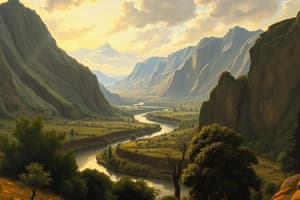Podcast
Questions and Answers
What is the long profile of a river?
What is the long profile of a river?
The long profile of a river represents the course of the river and its journey from the source to the mouth.
What are the three sections of a river's long profile called?
What are the three sections of a river's long profile called?
The three sections are the upper course, middle course, and lower course.
What are the characteristics of the upper course of a river's cross profile?
What are the characteristics of the upper course of a river's cross profile?
The upper course has deep valley sides and a narrow river channel.
What is the Bradshaw model used for?
What is the Bradshaw model used for?
What are some landforms found in the upper course of a river?
What are some landforms found in the upper course of a river?
What are some characteristics of the middle course of a river?
What are some characteristics of the middle course of a river?
What are some features of the lower course of a river?
What are some features of the lower course of a river?
What is river discharge and how does it change from the upper course to the lower course?
What is river discharge and how does it change from the upper course to the lower course?
Describe the changes in erosion along the different courses of a river.
Describe the changes in erosion along the different courses of a river.
Explain how transportation and deposition change as the river flows from its source to its mouth.
Explain how transportation and deposition change as the river flows from its source to its mouth.
How does the load size of sediment change along the course of a river?
How does the load size of sediment change along the course of a river?
Flashcards are hidden until you start studying




